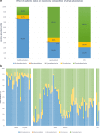Comprehensive detection and identification of bacterial DNA in the blood of patients with sepsis and healthy volunteers using next-generation sequencing method - the observation of DNAemia
- PMID: 27771780
- PMCID: PMC5253159
- DOI: 10.1007/s10096-016-2805-7
Comprehensive detection and identification of bacterial DNA in the blood of patients with sepsis and healthy volunteers using next-generation sequencing method - the observation of DNAemia
Abstract
Blood is considered to be a sterile microenvironment, in which bacteria appear only periodically. Previously used methods allowed only for the detection of either viable bacteria with low sensitivity or selected species of bacteria. The Next-Generation Sequencing method (NGS) enables the identification of all bacteria in the sample with their taxonomic classification. We used NGS for the analysis of blood samples from healthy volunteers (n = 23) and patients with sepsis (n = 62) to check whether any bacterial DNA exists in the blood of healthy people and to identify bacterial taxonomic profile in the blood of septic patients. The presence of bacterial DNA was found both in septic and healthy subjects; however, bacterial diversity was significantly different (P = 0.002) between the studied groups. Among healthy volunteers, a significant predominance of anaerobic bacteria (76.2 %), of which most were bacteria of the order Bifidobacteriales (73.0 %), was observed. In sepsis, the majority of detected taxa belonged to aerobic or microaerophilic microorganisms (75.1 %). The most striking difference was seen in the case of Actinobacteria phyla, the abundance of which was decreased in sepsis (P < 0.001) and Proteobacteria phyla which was decreased in the healthy volunteers (P < 0.001). Our research shows that bacterial DNA can be detected in the blood of healthy people and that its taxonomic composition is different from the one seen in septic patients. Detection of bacterial DNA in the blood of healthy people may suggest that bacteria continuously translocate into the blood, but not always cause sepsis; this observation can be called DNAemia.
Conflict of interest statement
Compliance with ethical standards Conflicts of interest The authors declare no conflicts of interest. Ethical approval All procedures performed in studies involving human participants were in accordance with the ethical standards of the institutional and/or national research committee and with the 1964 Helsinki declaration and its later amendments or comparable ethical standards. The research was granted approval by the local Bioethics Committee of the Jagiellonian University (KBET/94/B/2009). Written informed consent was obtained from participants before their enrollment in the study.
Figures





References
-
- Umeh OD, Sanu OO, Utomi IL, Nwaokorie FO. Prevalence and intensity of bacteraemia following orthodontic procedures. Int Orthod / Coll Eur Orthod. 2016;14:80–94. - PubMed
MeSH terms
Substances
LinkOut - more resources
Full Text Sources
Other Literature Sources
Medical

